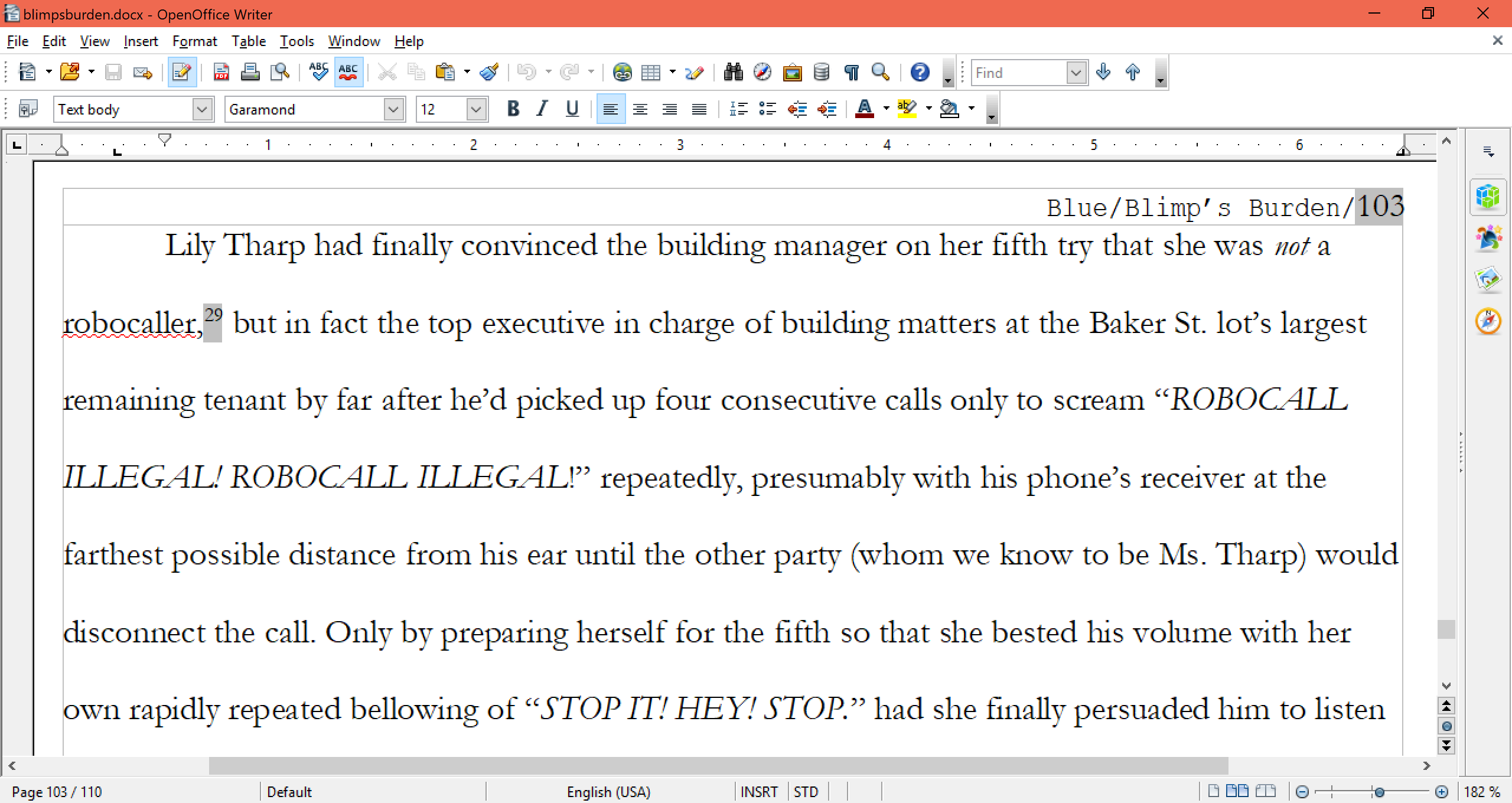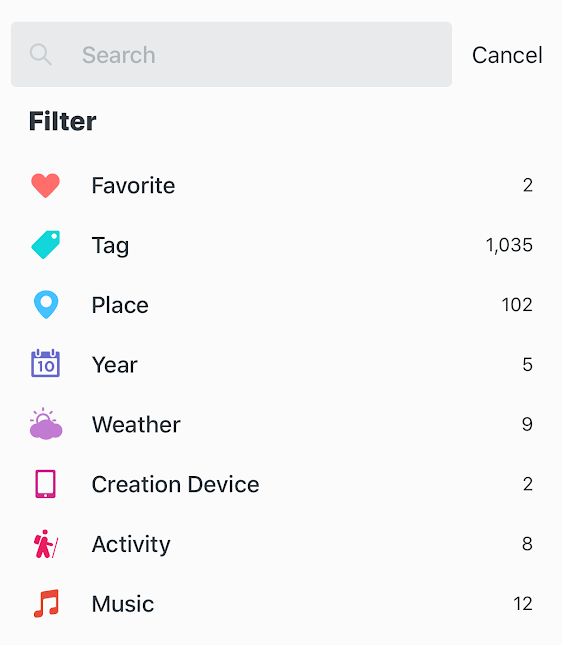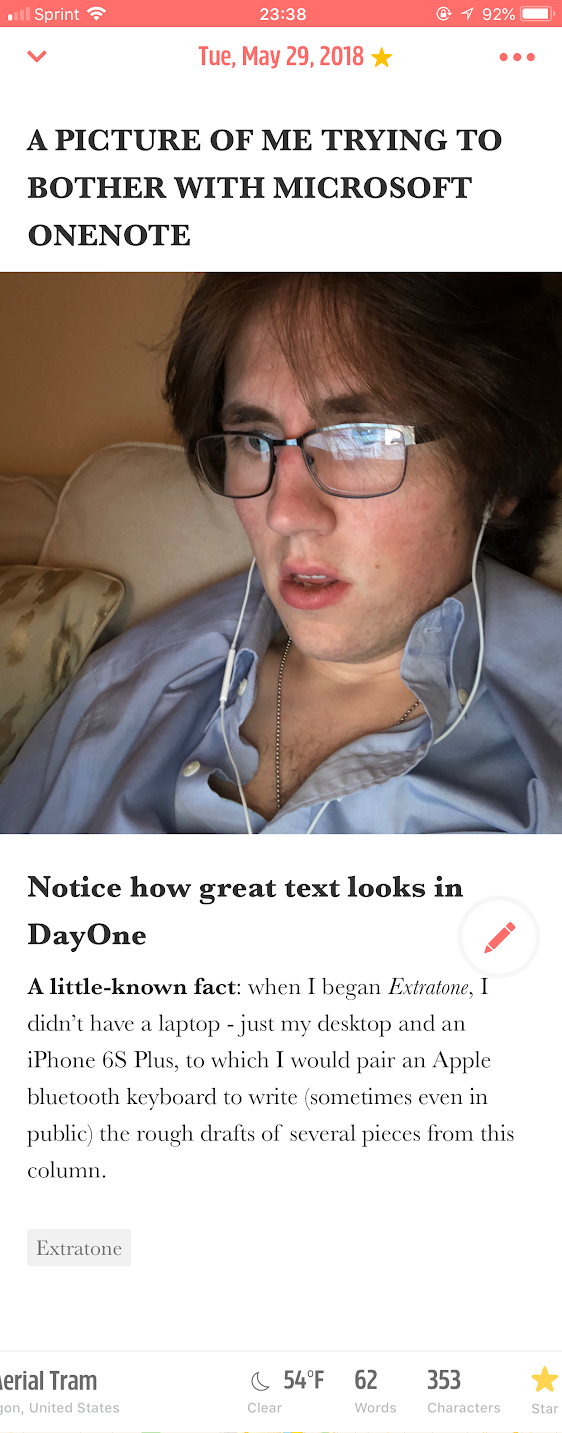
I have only once in my many using years been gripped by the fear of the Lord because of a software-related event. I was cruising my pitifully ugly Google News feed on an October afternoon in 2015 looking for the last little bit of material for the evening’s episode of *Drycast,* when I happened to spy the words “Evernote is in Serious Trouble.” I doubt I screamed or anything, but I definitely remember experiencing a very real, full-body shot of adrenaline because my entire creative life was contained at the time within the nearly 40,000 notes I’d amassed on my Evernote account since the service’s open beta in 2008. In fact, I was in that very moment using it for the live show notes and so began to wonder how I could possibly continue if Evernote were to be suddenly killed dead. For better or worse, though, the “unicorn” would indeed survive to see its tenth birthday this year, though it’s arguably been eclipsed by the notetaking, journaling, and word processing services its features predated and for which it was the most significant forerunner not so long ago.
I’d been using the cloud-synced notetaking service for all of my composition and research gathering since Junior High, when I thought myself extremely clever with my cloud-syncing, iPhone-native notetaking app when I’d watch other students struggling to find a flash drive or log in to their email on school library computers. Since it worked with any browser and my password was memorable (before the brute force apocalypse and the need for password managers,) I could access my documents, mp3s, and images from anywhere, which was actually a pretty big deal — especially as more research and notetaking was required in high school.
Yes, 10 years later, we are swamped with infinite duplicates of documents from our personal clouds, which are now inescapable and plenty — they follow us around from our pockets, purses, and backpacks and rain notifications down upon us for single punctuation mark peer edits, unnoticeable modification conflicts, or sometimes just for the hell of it. There are now what seems like infinitely many available ways to enter, edit, and publish text from wherever you happen to be, and most of them are free, but very few are actually pleasantly executed tools — all of which can all be said of most types of software now. Since tech publications (and even tech bloggers now,) aren’t doing software reviews anymore because you won’t click on them, the task of comparing between the lot so that you might be spared having to mess around with all of them to find out for yourself — the function of consumer journalism — has fallen to myself, alone because the Fear of The Unclicked is not known to me.
To assist me in bearing this terrible burden, you can allocate 1–3 minutes to take the survey I created about the text-entry tools you use ****to determine which tools people use at different points in their writing process and across several uses. It would be very much appreciated.
Reading this via printed PDF, your hypothetical 100% offline grandmother — the successful children’s book author who needs word processing but doesn’t require connectivity because she doesn’t do research or correspond with anyone — might ask well whatever was the matter with Microsoft Word? Surely I don’t need more than that! Technically, she’d be correct in a major sense: Word has been able to sync via Microsoft OneDrive between PC or Mac with iOS or Android for a while now, but I wouldn’t vouch for the latter for any use other than reading or very lightly editing a document because the relationship between the mobile apps and their desktop counterparts is inevitably strained. Because Microsoft Word is such old software, it’s filled with some obscure functionalities I’m sure even its creators have forgotten. Over years and years of development, these tools have been stacked on top of one another so that actually mastering the labyrinth could be a college major in and of itself.
Basically, you can tell your grandmother that Microsoft Word is a huge old bitch, but it’s still the industry standard for formatting and publishing works at the end of the line. As you can see from our survey results, 58.1% of you use “legacy” word processing software to finish up your first drafts (as of May 30th,) which makes you more modern than even a slightly-older population, I’d wager.
While we’re on the subject of the old hag, it’s worth pointing out how ridiculously behind the times its open source “alternatives” are. OpenOffice’s last major update was the release of version 4.0 in July of 2013, and it’s not correctly scaled for the small, high-DPI displays sold at just about every price level, nowadays. It was okay when I couldn’t afford to pay for a license in high school (and saw no reason to,) but it now looks sort of awful, especially considering that the version of Office (and therefore Word) to which I’m comparing its screenshots is actually also from 2013.
The other, “fresher” open source option of the moment is called LibreOffice Writer, and its suite has been attracting a fair amount of praise — I think “every bit as good [as Word]” is taking things a bit far, but its sixth version looks significantly better than OpenOffice on my machine, at least, and generally operates more smoothly as well. That age-old banner of Open Source won’t matter for much longer, though, if all kinds of software continue to be abandoned and substituted with Progressive Web Apps for no damned reason. Considering how much time some of us have already spent in front of Word, it’s no wonder we’re spoiled: even my 5-year-old edition of Microsoft Office syncs with the app on my iPhone (with some pleading,) and looks extremely crisp. As far as paid featured desktop-class alternatives, there’s just one more: WordPerfect, which I have never used or heard anyone else mention.

Microsoft Word 2013

OpenOffice 4
When it was conceived, Evernote pioneered the recipe that now serves as the foundation of the feature development in today’s notetaking and journaling applications, as evidenced by CEO Phil Libin’s unapologetic use of the term “life-logging” in 2009, which sounds bizarre in retrospect because we’re now well-accustomed to easily “snapping geotagged photos” (smartphones had always included location data in their photo files’ meta, but Evernote was the first app to give a user access to the data on their device,) “making voice notes,” or and organizing text notes via advanced categorization and metadata-enabled searchability. These features are essentials in the apps you could accurately describe as “life-loggers” available for download now. Snapchat’s “Memories” especially come to mind, and I’ve long argued that we should blame (or praise) Evernote for beginning the era of eternal memory.
The iPhone OS app’s design would even influence Apple’s own additions to its native photo and note applications in iOS7, much further down the line. Its technical doctrine of on-device storage coupled with syncing via The Cloud would inspire both Microsoft’s OneNote and Bloom’s gorgeous DayOne. There was even a “full-featured” Linux-running offshoot called NeverNote.
In contrast with Evernote’s relatively busy design, DayOne has been the best-looking app of any kind on iOS for years. It shipped with the same sort of extensive categorization, but it’s only ever been available on iOS, Android, and OSX — probably because Windows simply doesn’t look good enough. Should you wish, it will add detailed metadata from the moment you begin each journal entry including precise-ish GPS coordinates, an overview of your location’s weather at the time, whether or not you were moving, what song you were listening to, and your step count for the day (now from the Health app.) You have the option of viewing your journal chronologically, by location on a map, or in a social-esque activity feed, and yes — its search function can be filtered by any of these datapoints.

DayOne for iOS.

In 2015, Bloom added iCloud syncing and multiple journals, further closing the functionality gap between the two apps on paper, yet plenty of users continue to tether between the two using IFTTT (including myself for all my Twitter favorites, just to compare.) Within the somewhat forgotten niche of the “life-logging” utility, DayOne is superior and serves well the self-obsessed user who find the little details of their life to be extremely interesting. Last Spring, they introduced the option to purchase a stylized physical book of a user’s journal from within the app. As it is currently priced, the 2,674-page book I previewed today containing every single Tweet I’ve favorited in the past 5 years displayed in a delicately-formatted layout would set me back over $365, and would have to be split into 5 separate books (as per the maximum of 400 pages each.) Since I find my life very interesting, I’ve made a note to myself to proceed if/when I ever have that sort of money to throw around.
For the 67.7% of you who use digital notetaking or word processing software when you “want to remember something,” DayOne is the best option available because of its search function and satisfaction-of-use. Though Evernote was once the only app that could “handle everything everything in your head,” it’s a different experience entirely — tailored for work applications, if anything, since DayOne’s growth spurt. The company, itself hasn’t exactly been managed cleanly, either with layouts in 2015 and a privacy scandal in 2016, but then again, what billion-dollar company doesn’t have its controversies?
Despite having imported my huge catalog of Evernote entries into DayOne, the former often gets stuck, and it’s retained the most irritating habit of all the software mentioned in this column. Because synced entries in Evernote are not live-updated like those in Google Docs or Dropbox Paper, it’s possible to modify or add to a note on one device while it’s open (and static) on another, which is addressed by either duplicating the most recent entry and filing it in the default “Conflicting Changes” folder, or pasting the duplicate of the entire contents above the “old” content in the note, separated by a horizontal line. I’ve yet to figure out the behavior that triggers which fix, but I don’t particularly care — I’ve decided to restrict my Evernote use to my desktop, absolutely. If I haven’t articulated it well enough for you to form a visual, just trust me: it’s very, very annoying, and it should’ve been addressed years ago.